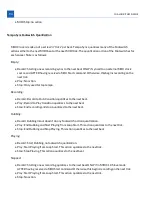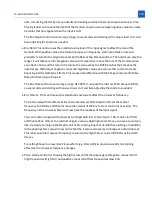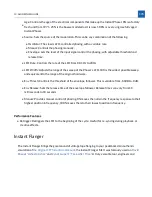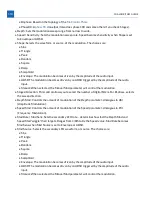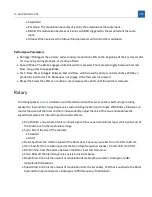
are familiar with those, it will be easier to see how the ENV controls can be used to add expression to
your playing.
Depth: This is the depth of the low and high bands of the tremolo. At 0, the tremolo will have no
effect on the volume of the bands. At 100, the bands will be completely faded in and out.
Rate: This is the base rate of the tremolo. When Tempo Sync is ON, this becomes a multiplier on the
tapped BPM value. The Env Rate control can change the apparent rate, so if the rate that you are
hearing is different from the value of the Rate control, try setting the value of Env Rate to 0.
Shape: The shape of the tremolo waveform. The same shape is used for both high and low bands.
The shapes describe what happens to the low band, since it’s usually the main part of your sound;
the high band will change in the opposite direction. Options are:
Sine: A sine wave. This shape works well for producing a smooth, subtle tremolo.
Fat Sine: A “fat” sine wave that spends more time near its minimum and maximum values. This
waveform sounds similar to Sine, but with slightly more throb.
Phat Sine: An even “fatter” sine wave that spends even more time at its minimum and maximum
values.
Triangle: A linear up/down ramp. Like sine, this is a good shape for smooth, subtle tremolo.
Ramp Dn: A downward ramp for the low band, and an upward ramp for the high band. The low
band will have a plucked attack while the high band will fade in.
Ramp Up: An upward ramp for the low band, and a downward ramp for the high band. The low
band will fade in, while the high band will have a plucked attack.
Pulse X: A pulse wave with selectable duty cycle (X). The low band will stay at its maximum
amplitude for X% of the cycle, then jump to its minimum amplitude, set by Depth and Env Depth.
Options are 25%, 33%, 50%, 66%, and 75%. This shape can be especially interesting when
paired with a delay pedal whose time is related to Harmadillo’s rate.
Lump: The
fi
rst half of a sine wave. The low band’s waveform is rounded at the maximum and
pointed at the minimum. This shape is good for making fast, vibey tremolos.
Rump: The second half of a sine wave (Rump is the inverse of Lump). The low band’s waveform is
pointed at the maximum and rounded at the minimum. Like rump, this is a good shape for fast,
vibey tremolos.
Slope X: A curved ramp wave with an adjustable slope.
X = 0: downward curve for the low band, upwards curve for the high band
X = 50: symmetric curves for low and high (similar to the RUMP shape)
X = 100: upward curve for the low band, downwards curve for the high band
•
•
•
•
•
•
•
•
•
•
•
•
•
•
•
•
10. ALGORITHM GUIDE
101
Summary of Contents for H90 Harmonizer
Page 1: ......
Page 6: ...9 Software Updates ...
Page 18: ...This page was intentionally left 99 88 blank ...
Page 30: ...This page was intentionally left 99 88 blank ...
Page 38: ...This page was intentionally left 99 88 blank ...
Page 56: ...This page was intentionally left 99 88 blank ...
Page 61: ...Fig 7 6 Input level display Fig 7 7 Output level display Exp Ctl 7 SYSTEM MENU 61 ...
Page 70: ...This page was intentionally left 99 88 blank ...
Page 160: ...This page was intentionally left 99 88 blank ...
Page 162: ...This page was intentionally left 99 88 blank ...
Page 168: ...This page was intentionally left 99 88 blank ...
Page 170: ...This page was intentionally left 99 88 blank ...
Page 175: ...This page was intentionally left 99 88 blank ...
Page 176: ... Copyright 2022 Eventide Inc ...








